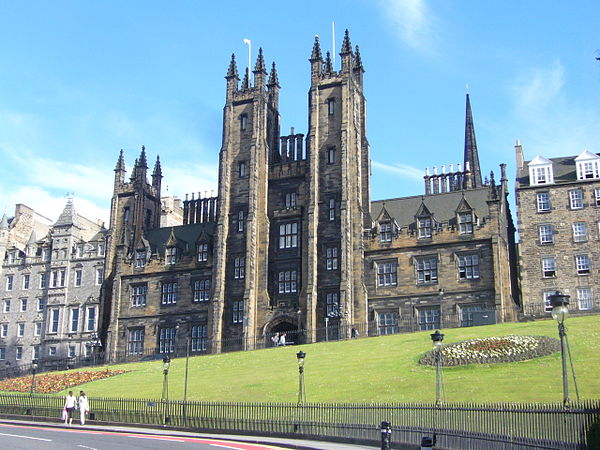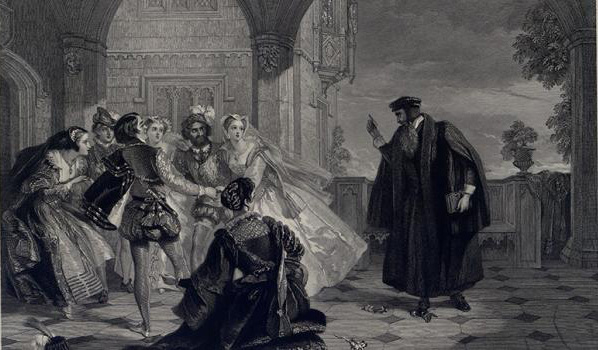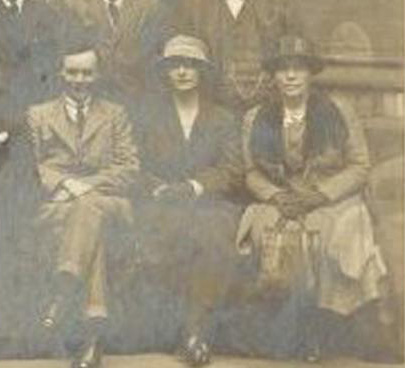
Stop 5 – New College Quadrangle
John Knox was the dominant founding figure of the Protestant Reformation in Scotland. He is not remembered for his love of women. While still in exile in Europe, he wrote a powerful polemic directed at women in authority: The First Blast of the Trumpet against the Monstrous Regiment of Women. He was thinking of Mary Queen of Scots and Elizabeth I[1].

Though this put Knox (left, admonishing Queen Mary and her courtiers) on a collision course with the most powerful women of his day (and it’s a wonder he died in his bed and not headless!), this doesn’t mean Knox didn’t like women! It was hinted that the twice-married father of five children was also something of a “ladies’ man”.
Still, Knox would have been as equally opposed to the idea of women standing in a pulpit as sitting on a throne. Yet over the years, many pioneering women have, quite literally, changed the face of Church in Scotland. We have already heard about Vera Kenmure, the first woman ordained in a Scottish mainstream denomination. Within the Church of Scotland, Scotland’s national denomination, things took a little longer.

Elizabeth Hewat (1895 – 1968) was among the first woman to study theology at New College, and the first to graduate, in 1926, with a Bachelor of Divinity degree.
Born in Ayr, Elizabeth (pictured right, in the centre) had already proved herself to be a woman of considerable intellectual ability, graduating with an MA from Edinburgh and taking up a post as assistant lecturer in history at the University of St Andrews. She moved to the progressive United Free Church Women’s Missionary College in Edinburgh from 1921, and while teaching there completed her BD at New College.
Elizabeth’s ambition was to work as a missionary, like her sister. But she also believed that to fulfil this role properly she should be ordained. Her case was brought to the 1926 United Free Church General Assembly, which was told that Elizabeth had come top of her class at New College, “making it difficult to argue that she could not be put on the same level as men”[2]. But the motion to ordain Elizabeth failed. Three years later, in 1929, it would be a much smaller Scottish denomination, the Congregational Union of Scotland, that would allow women to be recognised as ministers in the same way as men.
Elizabeth herself went to join her sister in China. She continued her academic work, achieving a PhD in 1933, also from New College. Moving to become Professor of History at Wilson College in Bombay, she was ordained as an elder in the United Church of North India and so frequently conducted worship in the Scots Kirk and elsewhere. Though never ordained into the Church of Scotland ministry herself, she helped lay the path for those who would be – led by another pioneer of ministry, Mary Lusk (later “Levison”).
Mary petitioned the Church of Scotland General Assembly of 1963 “to test her call to the ministry of Word and Sacrament”. Mary was already a deaconess and formidably well educated. She had represented the Church of Scotland at the World Council of Churches 4th Assembly and, in 1957, had become the first woman in the Church of Scotland to be licensed to preach. But this wasn’t yet enough for the General Assembly, which rejected her petition.
The tide had turned, however, and the debate led inexorably to a decision in 1968 for Scotland’s national church to open ordained ministry to women on the same terms as men. The Herald newspaper likened what Mary had achieved for women in ministry to what Sophia Jex-Blake had achieved for women in medicine.
Mary herself had married by this time and (by her own choice) wasn’t ordained until 1978, by which time she was already an assistant minister at what was then St Andrew’s and St George’s Church on George Street. From there, Mary Levison, as she now was, worked as a chaplain to the city centre’s shops. In 1991, she was appointed a Queen’s Chaplain – the first woman to hold the position. We have to ask ourselves what John Knox would have made of that!
REFLECTION
Elizabeth Hewat expressed her conviction that it was “not Christ barring the way” for women in ministry. And Mary Levison, in her autobiography, described herself as “wrestling with the church”.
How often do those on the “outside looking in” at the Christian Church ask themselves, “Why is the Church struggling to keep up with the times?” Richard Holloway, the former Bishop of Edinburgh, said some years ago that the Church was slow to campaign against slavery; it was slow to campaign for the ordination of women; and where LGBTQ rights were concerned it hadn’t even got started. Even today, Holloway’s basic argument still stands: Given the radical nature of Jesus’ ministry, why does the Church have such a marked tendency towards conservatism, with a small ‘c’?
Click here for further information.
[1]
The women in question were the queens of his time, including Mary Queen of Scots and Elizabeth I. He used the words “monstrous” and “regiment” in an archaic sense to mean “unnatural” and “rule,” arguing that female dominion over men was against God and nature. He lamented that the future of the Protestant faith lay solely in the hands of a female monarchy largely hostile to its precepts. Unlike John Calvin, for instance, he opposed the rule of women even in cases when there was no male heir to the throne.
[2]
From Lesley Orr’s entry into The New Biographical Dictionary of Scottish Women p.198


